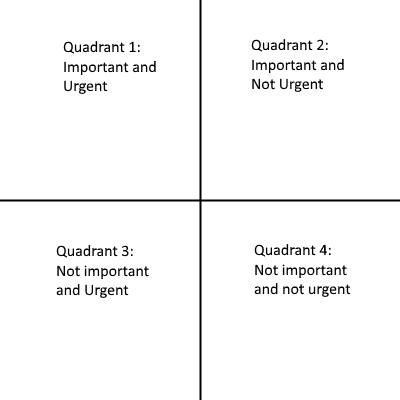
Prioritization 101 – Part 2
There is a lot of talk in the productivity and life-betterment spheres about priorities. “Choose your priorities!” “Set your priorities!” “Work on your highest priorities first!” Articles all about priorites are everywhere. But what exactly are priorities, and why do we need them? And how do we determine what they are?
I’ve been around the productivity and lifehack worlds for a long time. And I’ve seen many methods of determining priorities. I’ve tried most of them as well, and I’ve come to the conclusion that for each person has to determine the method that works best for them. This is the second of two articles in which we look at various methods of prioritizing tasks, along with their pros and cons.
Quadrants
The quadrant method takes into account both urgency and importance. Often attributed to President Eisenhower, it has you put tasks into four quandrants. Importance is how important the task is to your overall goals. Urgency is how quickly something needs to be done.
Quadrant 1 is for those tasks that are important and urgent. This includes tasks like submitting an article for publication to meet the deadline on Friday; doing budget numbers for your department, due tomorrow; and proofreading your teenager’s history paper, due tomorrow.
Qudrant 2 is for those tasks that are important but not urgent. This would include tasks such as spending time with your child reading; writing the novel you have always wanted to write; and
Quadrant 3 is for those tasks that are urgent but not important. These are things like tackling Mt. Washmore; cleaning the old food out of the refrigerator; and answering email from a colleague who needs numbers for a report he has due at the end of the day.
Quadrant 4 is for those tasks that are not urgent and not important. These are things like organizing the mugs on the counter; reading email newsletters; surfing the web for ideas for your next home improvement project.
The idea is to weed out those tasks that are likely to become crises, while at the same time getting to the things that matter. Articles have been written that say you should delegate those things that are in quadrant 3, ignore those that are in 4, and try to work as much as possible from quadrant 2.
Pros: matrix planning is good because it takes into account the importance of a task. It also gives you a good picture of those things that need to be delegated or deleted.
Cons: like the ABC123, tasks can mover around, and those things that are currently not urgent may flare up into crises without careful management. There is also some debate about the concept of “important” – and things that may not be important today (laundry) might be very important tomorrow.
MITs
MIT stands for Most Important Task and has nothing to do with the university. This concept I first read about over at Zen Habits. The idea is to pick your three most important tasks and do those before doing anything else. This gets three important tasks out of the way before you consider anything else, urgent or not.
Pros: this method makes sure that you make progress on the important things by placing them before the urgent ones. It also allows you to focus on a very short list of items, making it easier to make progress without being overwhelmed.
Cons: This method doesn’t work well for those who don’t set their own schedules because it doesn’t take on time constraints. I have also read that once you have these three things done, you don’t have to do anything else; this only works if you are applying the method to a specific area of your life, like work or housework.
1-3-5
The 1-3-5 method is an expansion of the MIT method. You pick a single most important task, then three tasks of lesser importance, then 5 more tasks. Once you have these tasks in place, you work down the list.
Pros: This method has more flexibility in actually doing tasks, because it only requires that you do the #1 task before doing anything on the 3 task list. It isn’t time bound. This method also gives you more to do, and an order in which to proceed. It doesn’t specify urgent over importance and you have a lot of flexbility in what to put on the list.
Cons: The 1-3-5 can make you feel more complacent about what you are doing, and nine tasks is a more appealing level to rest on. However, this can allow you to quick working too fast; and its restriction on order makes it hard to apply to a whole life. It is better suited to subsets of life, like the MIT method.
Feeling
I’ve been a fan of Mark Forster for for many years. He is a proponent of unlisting and scanning. His task management systems are varied, and are well thought-out and tested. He often will test a new system and report has he goes on his blog.
Most of his systems call for an approach where you scan a list of tasks and act on the ones that call out to you. The thought behind this is that the most important and urgent will catch your attention. His latest system, called Final Version, incorporates this method of working.
The basic method is you make a big list, and then you scan smaller chunks of it (like a page) and do what catches your eye. There are various rules about handling new tasks, not finishing tasks, and what to do when nothing catches your eye, based on the different systems.
Pros: I have found that the various Mark Forster methods are great ways to get lots of tasks done. I seem to triple my productivity because I know I don’t have to finish a task before moving on, and I can choose what I will.
Cons: the pace inspired by these methods is hard to sustain, and many times I am exhausted after a few days of working the system. It also doesn’t do anything about procrastination, and whole pages of tasks can be skipped multiple times.
Summary
No matter which method of prioritization you pick, from the rigidity of ABC123 to the gut-feeling systems of Mark Forster, you will accomplish more if you have a prioritization method you apply to your tasks.
Do you have a method of prioritization? Tweet your favorite to me @LJEarnest using #prioritization.
Further reading:
Time And Live Management, Weber State University
Dwight Eisenhower’s Best Productivity Tricks
Purpose Your Day: Most Important Task (MIT), Zen Habits
A Better To-Do List: The 1-3-5 Rule
The Final Version By Mark Forster
Image by Neil T. Licensed under Creative Commons. Text added.
”
https://creativecommons.org/licenses/by-sa/2.0/




